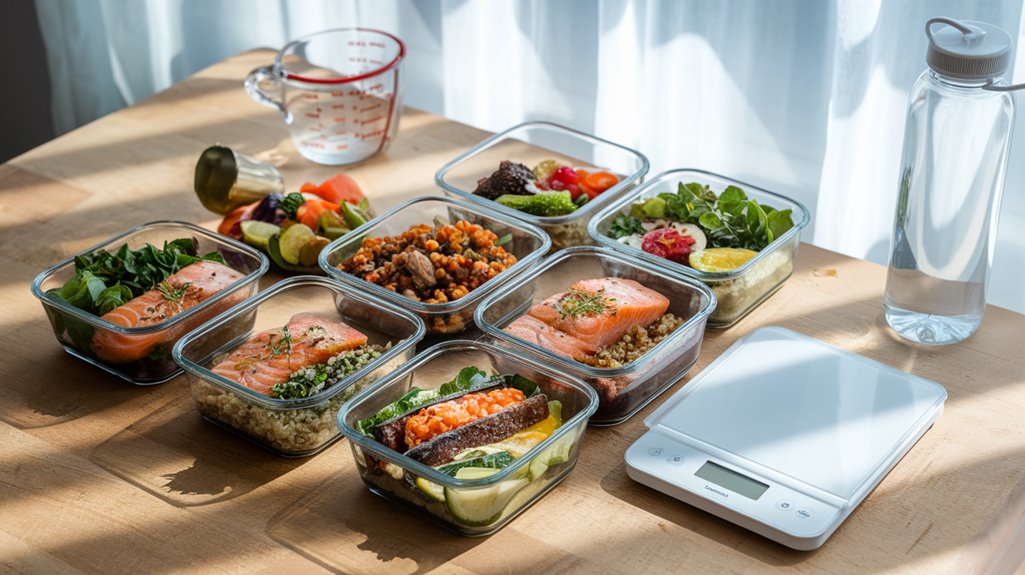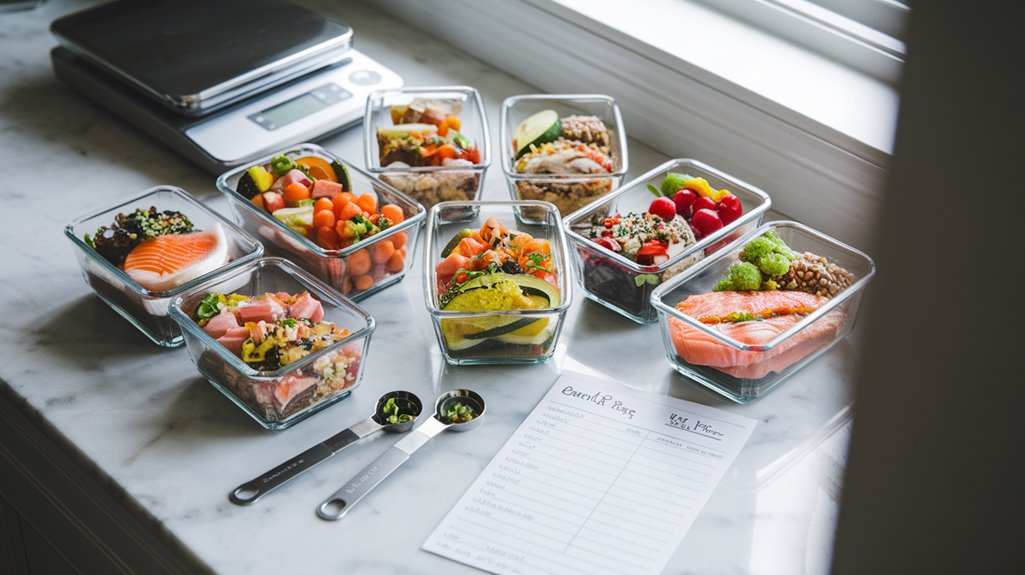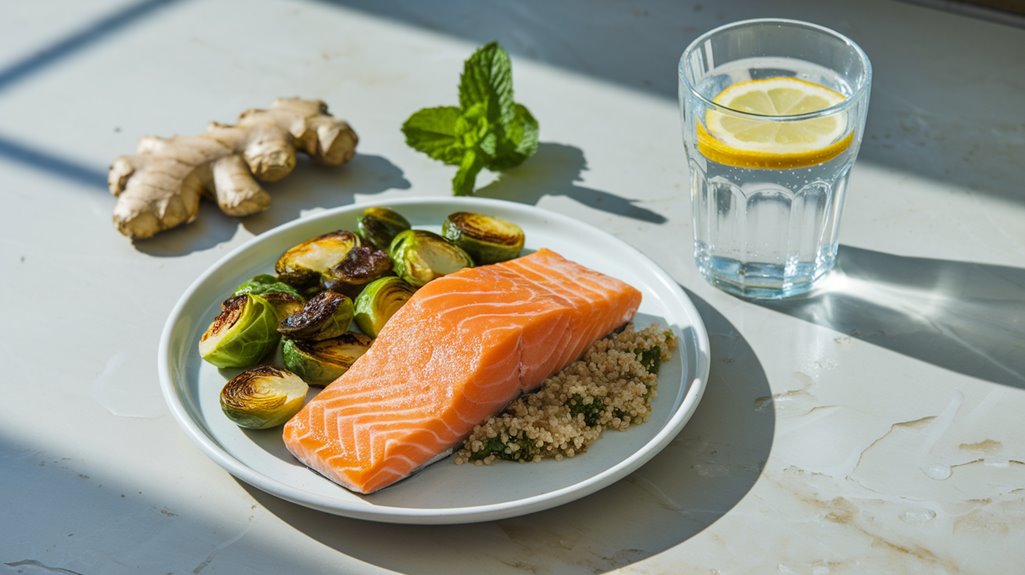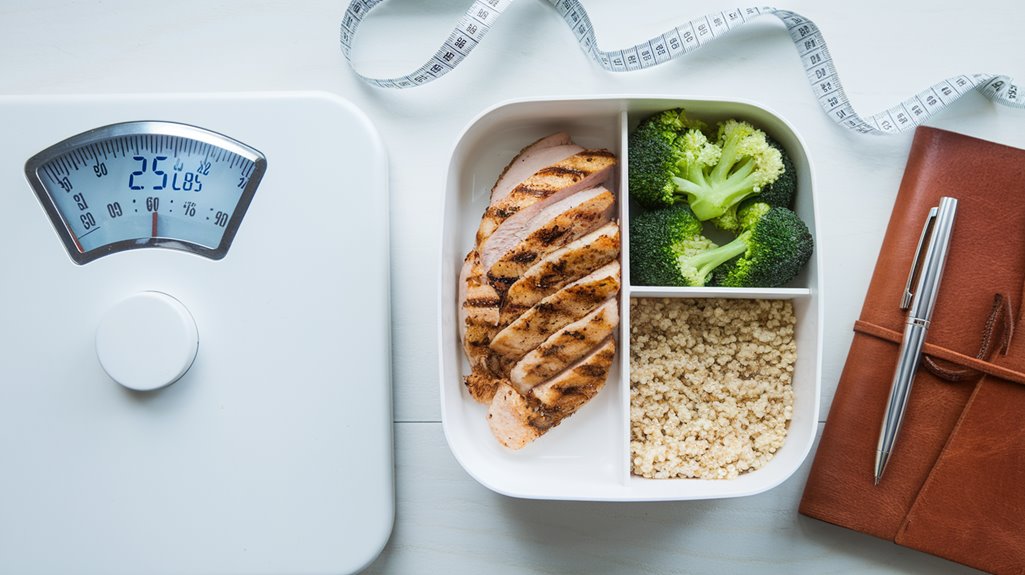Discover the secret 7-day Mounjaro meal plan that transforms your weight loss journey and unlocks incredible results.

You can maximize Mounjaro's weight loss potential by following a strategic meal plan that aligns with the medication's dual-action mechanism. The key is structuring your daily intake around 1400-1600 calories, divided into 3 main meals and 2-3 protein-rich snacks. Focus on lean proteins, complex carbs, and plenty of vegetables while staying hydrated with 2-3 liters of water daily. A properly structured 7-day plan can help you achieve up to 15% weight loss. Let's explore exactly how to build your personalized protocol.
While Mounjaro has gained attention for its weight management potential, understanding its mechanism of action is vital for successful treatment. As a GIP and GLP-1 receptor agonist, Mounjaro works by mimicking natural hormones that regulate blood sugar and appetite. You'll experience increased insulin production after meals, along with reduced glucose release into your bloodstream.
What sets Mounjaro apart is its dual action: it slows down how quickly food moves through your stomach while simultaneously decreasing your appetite. Studies show promising results, with participants losing an average of 15% of their body weight over 72 weeks. However, you won't see guaranteed weekly weight loss amounts, as results vary considerably between individuals.
Remember that Mounjaro isn't a standalone solution. You'll need to combine it with a balanced diet and regular exercise for best results. Regular health monitoring and ongoing medical supervision are essential for successful weight management with this medication. Starting at 2.5 mg once weekly, your doctor will gradually adjust your dosage to find the most effective treatment plan.

To maximize Mounjaro's effectiveness, following proper nutrition guidelines becomes essential for your weight management journey. You'll need to focus on consuming lean proteins like skinless poultry and fish, aiming for 0.75-1.6g per kg of your body weight daily, distributed across 20-30g portions per meal.
Incorporate complex carbohydrates through whole grains such as brown rice, quinoa, and oats, targeting 3-5 servings daily. You'll want to structure your meals around nutrient-dense foods, spacing them 4-6 times per day at 3-4 hour intervals. Understanding that gastric emptying slows with Mounjaro helps explain why smaller, frequent meals work best.
Stay hydrated by drinking 2.0-3.0 liters of water daily, depending on your gender. Keep healthy fats to 2 tablespoons per meal, and limit alcohol to gender-specific guidelines. You'll benefit from consulting a healthcare provider for personalized recommendations, especially when managing portion sizes and selecting low-sodium options that complement your Mounjaro treatment plan.
Your personalized 7-day meal plan combines protein-rich foods with precise portion control, ensuring you'll meet the 1400-1600 calorie target while taking Mounjaro. You'll find easy-to-prepare recipes that emphasize lean proteins, fiber-rich vegetables, and whole grains, spread across three main meals and two strategic snacks daily. The plan's flexibility allows you to adjust portion sizes and meal timing to match your medication schedule and lifestyle needs while maintaining blood sugar stability. Pairing this plan with Mounjaro can help you achieve up to 21.1% weight loss when followed consistently.
Success with Mounjaro depends heavily on strategic meal timing and portion control throughout the day. You'll want to aim for 1400-1600 calories, distributed across three main meals and two to three snacks. Start with breakfast by 9 a.m., followed by lunch between 12-2 p.m., and dinner at least four hours before bedtime. Research shows that late night eating can disrupt metabolism and blood sugar management.
Keep your snacks between 100-200 calories, focusing on high-protein, high-fiber options to maintain satiety. You'll achieve better results by front-loading your calories earlier in the day. Each meal should combine lean proteins, high-fiber carbohydrates, and modest portions of healthy fats. Remember that these guidelines aren't one-size-fits-all – your specific caloric needs may vary based on factors like weight, height, activity level, and individual health goals.
When following a Mounjaro-optimized meal plan, incorporating adequate protein becomes essential for managing hunger and preserving muscle mass during weight loss. You'll want to distribute your protein intake across breakfast, lunch, dinner, and snacks, aiming for 46-56 grams daily at minimum.
Start your day with Greek yogurt paired with berries or eggs with whole-grain toast. For lunch, opt for lean chicken breast, tuna, or lentils served with fiber-rich vegetables. Dinner should include protein sources like salmon, turkey, or tempeh alongside complex carbohydrates. This approach helps you experience higher satiety hormone levels throughout the day, naturally reducing your appetite. Choose protein-rich snacks such as edamame, chickpeas, or hard-boiled eggs between meals. Remember to prep your meals in advance and maintain portion control while staying hydrated throughout the day.
Creating a successful Mounjaro meal plan starts with efficient, protein-rich recipes that you can prepare ahead of time. You'll want to focus on high-protein, low-calorie options like Instant Pot frittatas and oven-baked egg white bites for breakfast, which provide sustained energy while supporting weight loss goals.
For lunch and dinner, consider preparing Greek chicken or spicy turkey meal prep bowls that offer balanced macronutrients. These dishes can be portioned into individual containers for the week. You'll also benefit from incorporating protein-rich soups like Thai red curry or chicken taco variations, which are both filling and macro-friendly. Using quality airtight containers will help keep your prepped meals fresh throughout the week.
To maximize efficiency, utilize one-tray prep methods and invest in quality meal prep containers. Don't forget to incorporate protein rice and adjustable portions to match your Mounjaro-supported weight loss journey.

Effective meal planning on Mounjaro starts with strategic shopping and organized meal preparation. You'll need to prioritize whole grains, lean proteins, and non-starchy vegetables while avoiding high-sugar and processed foods. Create categorized grocery lists to prevent impulse purchases, and opt for fresh or frozen fruits without added sugars.
Set yourself up for success by investing in essential meal prep tools like portion-controlled containers, measuring cups, and a food scale. Schedule dedicated prep time each week to prepare 3-5 rotating recipes, focusing on balanced meals that include lean protein, fiber, and healthy fats. You'll want to make breakfast efficient with grab-and-go options like egg muffins or chia pudding. Choose foods like skinless poultry and tofu to maximize your protein intake while keeping fat content low.
As your appetite changes on Mounjaro, adjust portion sizes accordingly using smaller containers. Stay hydrated by drinking 6-8 servings of fluids daily between meals, and incorporate high-protein foods like lean meats, fish, and eggs into your meal plan.

Successfully managing Mounjaro's side effects requires strategic dietary adjustments that can greatly improve your treatment experience. Start by eating smaller, frequent meals throughout the day to minimize nausea and digestive issues. Choose bland, easily digestible foods like toast and rice while avoiding fatty, fried, or spicy items that can trigger discomfort.
To manage constipation, increase your fiber intake through whole grains and non-starchy vegetables. Stay well-hydrated by sipping water consistently throughout the day, which helps with multiple side effects including nausea, constipation, and heartburn. You'll want to avoid high-sugar foods, artificial sweeteners, and excessive sodium, as these can worsen gastrointestinal symptoms. Since mild side effects typically resolve within days to weeks, maintaining these dietary habits during the initial adjustment period is crucial.
Focus on incorporating lean proteins and low-fat dairy products while eating slowly and chewing thoroughly. If you're experiencing persistent side effects, consider working with a registered dietitian who can create a personalized plan tailored to your specific needs and reactions.

Tracking your progress on Mounjaro requires more than just daily weigh-ins – you'll want to measure body composition, take progress photos, and log your energy levels to get a complete picture of your health journey. Set SMART goals (Specific, Measurable, Achievable, Relevant, Time-bound) that focus on both scale and non-scale victories, such as improved blood sugar readings or increased physical activity. Regular monitoring allows you to make data-driven adjustments to your meal plan, ensuring you're maintaining a healthy calorie deficit while meeting your nutritional needs. Most patients can expect to see up to 20% weight loss after eight months of consistent treatment and proper tracking.
While following a Mounjaro meal plan, monitoring your daily weight provides essential data for optimizing your weight loss journey. Weigh yourself each morning after using the bathroom and before eating or drinking. Stand on a reliable digital scale placed on a hard, flat surface while wearing minimal clothing. Consider tracking your body fat percentage using a smart scale that transmits electrical signals for a more complete picture of your progress.
| Time of Day | Action | Why It Matters |
|---|---|---|
| Early Morning | Empty stomach weighing | Most accurate baseline |
| Same Time Daily | Consistent timing | Reduces fluctuation variables |
| Post-Bathroom | Empty bladder/bowels | Eliminates waste weight |
| Pre-Breakfast | No food/drink yet | Prevents meal weight impact |
Track your measurements using a smart scale or app to identify patterns and adjust your meal plan accordingly. Remember to maintain consistent weighing conditions for the most reliable progress tracking during your Mounjaro treatment.
A thorough approach to measuring progress on Mounjaro extends well beyond the numbers on your bathroom scale. You'll want to track your progress using multiple methods, including monthly photos, tape measurements, and clothing fit.
Take front and side photos every four weeks under consistent lighting and poses. Use a tape measure to track changes in your waist, hips, thighs, biceps, and chest circumference. Notice how your clothes fit differently as you lose weight and gain muscle. These combined metrics provide valuable insights that weight alone can't reveal.
Use this extensive data to make informed adjustments to your meal plan and exercise routine. While body fat percentage tools aren't reliable for short-term tracking, consistent monitoring of measurements and photos will help you identify patterns and guide necessary changes to optimize your Mounjaro journey.
Track your progress consistently using your preferred method – whether it's a smartphone app, paper journal, or wearable device. Research shows that regular monitoring of both food intake and physical activity leads to better weight loss outcomes. You'll want to record daily meals, caloric intake, and exercise sessions. Make adjustments to your meal plan based on your tracking data, and don't hesitate to modify your approach when needed. Remember, consistency in tracking matters more than the specific method you choose.
You're now equipped with a science-backed strategy to maximize your Mounjaro journey, like a skilled navigator charting the safest course through unfamiliar waters. By following this structured meal plan, tracking your progress, and making informed adjustments, you'll optimize your medication's effectiveness while maintaining proper nutrition. Remember to stay in close contact with your healthcare provider and adjust this framework to your individual needs and responses.